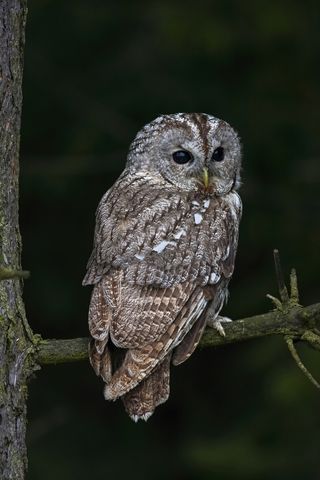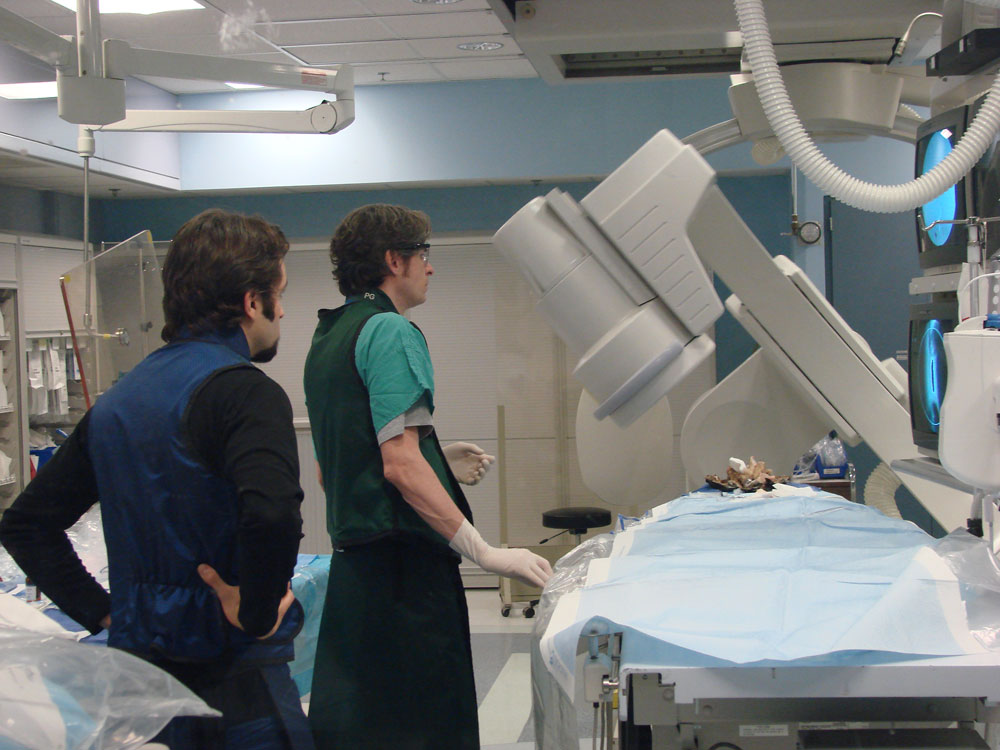How Many Degrees Can an Owl Turn Its Head
Biological Twist: How Owls Spin Heads Around

Owls don't need eyes in the back of their heads to see what's behind them — they can just swivel their heads all the way around. In fact, many owl species, such equally the barred owl, tin can rotate their heads 270 degrees in each direction, which means they tin await to the left by rotating all the way to the right, or vice versa.
Just how practise they do it without severing their arteries or preventing blood from reaching the encephalon? An illustrator and a physician at the Johns Hopkins Academy Schoolhouse of Medicine teamed up to find out.
"Until now, brain imaging specialists like me who deal with human injuries acquired by trauma to arteries in the caput and cervix accept always been puzzled as to why rapid, twisting caput movements did not leave thousands of owls lying dead on the forest floor from stroke," said report author Dr. Philippe Gailloud, in a statement from the university.
If humans tried to rotate our heads so rapidly or far, we'd tear the lining of our arteries, which would cause clots to course and lead to a stroke (besides too breaking our necks), he added. "The carotid and vertebral arteries in the neck of most animals — including owls and humans — are very frail and highly susceptible to fifty-fifty small tears of the vessel lining."
Looking inside owls
To get a glimpse of the owl's blood vessels when their necks were turning, the duo injected dye into the blood vessels of a dozen expressionless owls and used a CT scan to visualize the shimmering fluid spreading throughout the birds' arteries like blood, said Fabian de Kok-Mercado, who performed the work while getting a main'southward in medical analogy at Johns Hopkins. (He is now an illustrator at the Howard Hughes Medical Institute in Chevy Chase, Md.) The researchers then twisted the dead owls' heads to run across what happened. [Video: Watch the owls' necks twist.]
After creating the CT scan images, the researchers injected a plastic-like substance into the veins of dead snowy, barred and great horned owls and dissected the animals, cartoon the routes and locations of the vessels.

They establish a number of previously undiscovered and unique traits, de Kok-Mercado told OurAmazingPlanet. For one, the owls' neck bones, or vertebrae, contain holes that are much larger than those establish in other birds or humans. In humans, the hole in the vertebra is well-nigh the aforementioned size as the artery, but in owls the hole is about x times larger than the avenue, co-ordinate to the study, published today (Jan. 31) in the journal Science. These holes, or canals, likely concur air sacks meant to cushion the twisting move of the head, de Kok-Mercado said.
"We too noticed right away that these canals were absent in the bottom two vertebra of the neck," de Kok-Mercado said. This gives the cord-like vessels some slack when the bird twists its caput.
The big holes and "slack" at the bottom of the neck help explicate why the vessels don't break. Merely they don't explicate why the supply of claret isn't cutting off when an owl turns its caput — with then much twisting, the vessels are bound to get partially blocked.
Blood to the brain
The squad noticed that the vertebral artery enlarges slightly as it approaches the brain, which is unusual and not seen in many other animals (like the trunk of a tree, vessels mostly go smaller every bit they get further from the center). The authors think that these enlarged areas may function as reservoirs in which blood tin pool, so that the encephalon has extra claret to work with as the caput swivels around, de Kok-Mercado said.
The blood vessels most the brain are also highly connected. A vessel called the patent trigeminal artery connects the forepart and the back of the owl'southward encephalon, which helps supply the organ with as much blood equally possible.
Why do owls need to crane their necks to such an extreme caste? Information technology's because their eyes are tubular, built almost like telescopes, giving them amazing vision, de Kok-Mercado said. But unlike humans, who accept roughly spherical eyes, owls cannot movement them well-nigh easily, so they have to rotate their heads.
The finding is simply another example of how the birds are perfectly adjusted to adjust their environment, enabling them to see despite having relatively fixed eyes.
"I hope it gives people more of an appreciation of the life on this planet," de Kok-Mercado said.
This story was provided by OurAmazingPlanet, a sister site to LiveScience. Accomplish Douglas Main at dmain@techmedianetwork.com. Follow him on Twitter @Douglas_Main. Follow OurAmazingPlanet on Twitter@OAPlanet. We're also onFacebookand Google+.
Source: https://www.livescience.com/26771-how-owls-rotate-heads.html

0 Response to "How Many Degrees Can an Owl Turn Its Head"
Post a Comment